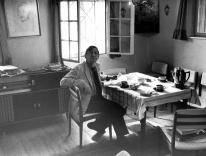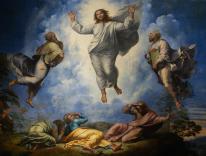My great-grandmother Luise Gönner had a keen eye for dead people. She would see them sitting by the side of the road sometimes when she worked in her garden in the morning, or waiting by the village crossroads at dusk, a look of mournful reproof in their eyes. Whether the sight alarmed or consoled her, I can’t say.
This quotation is from an interesting article in the September 12th New Yorker called Where Germans Make Peace With Their Dead by Burkhard Bilger. It's about a therapy being used in Germany to reconcile people to their family's past, using friends and family to channel their dead relatives (and channel other things as well). It makes a good addition to Rand Cooper's article The Inner Exile of Fritz Reck.
The therapy is bound up with beliefs of the dead and while I will talk about it below the fold, the first thing that struck me about it was that I was reminded of my own childhood. The Catholicism I grew up with was (like Bilger’s) infused with a belief that the dead walked among us in very tangible ways. One of my earliest memories was of my grandmother's bedroom in her apartment. She had an old cheap rocking chair that stood next to the window. Once I saw it move a little by itself. I wasn't concerned, but I was curious. "Grandma, why did the rocking chair just move?" "It's just a dead person" she responded. "Probably a relative just by for a visit."
This made sense to me (I was about four). When someone had a bruise appear on their arm or leg that they couldn't remember getting, it was callled a "dead man's pinch". Any sudden draft was a dead person brushing by. There was a story of an uncle who died in the War and when his ship was sunk a picture (of Jesus, of course) fell off the wall at what turned out to be the moment that it happened. Relatives appeared in dreams, sometimes giving news of current and future events or sometimes just reporting in just after dying. And they knew, really knew, if you did or didn't pray for them. They were always around, watching. My Irish grandmother, who had actually heard the banshee in her village when a pair of twins had died of influenza nearby, would always take the hand of the corpse when she went to a wake, explaining that doing so would keep its wandering soul away.
Ireland was a haunted country with a human population of 3.5 million and a ghost population ten times larger. But if one really wants to see a country full of ghosts, Germany is where you want to go.
The article is written from Bilger's own point of view as the son of family of expatriates who came to America in 1962. He speaks German and has traveled there frequently. In the article, he is there trying to find out information about his grandfather, who he had met as a child. His feelings about his grandfather were mixed and he wanted to know more.
He always made me a little nervous. Tall and gaunt, with a shock of peppery blond hair, he had a glass eye that would swivel disconcertingly out of line as he spoke. He would ask me questions in a grave voice, like an anthropologist interviewing a Pygmy, and he sometimes gave me a piece of beeswax with honey to chew—strange, like him, with its chambered secrets, but also sweet.
Over time, he had discovered that his grandfather had been a sort of war criminal. He got the glass eye in World War 1. He joined the Nazi party in 1933 and had eventually been assigned during the war as a school teacher in occupied Alsace, where he became the Nazi leader of the village. He was described as a very good man and a rabid Nazi.
But such stories are common in Germany. The thing about them is that the Germans were quite aware of their guilt from World War 2 and for a generation didn't talk about it. The generation that fought that war is almost gone and their children are now old and have become ready to deal with their own past. They do this in public ways, but most importantly, they are doing it in structured private ways via things like the therapy that Bilger describes.
Small groups of people are assembled in a room by a therapist. The assembly is called a Familienaufstellung, or family constellation. One person becomes the subject of the therapy. He goes around the room and assigns a role to each person. Sometimes the role is of a dead relative or ancestor. Sometimes is of a concept, like Fear or God or Germany. Then the members of the group stand and move to the center of the room and try to take on the role they have been assigned. Sometimes this role playing causes strange things to happen. Some people actually feel like they are channeling the dead. When they are ready, they begin to interact with the subject who asks them questions to which they are to respond in character. The questions are usually the hard questions and demands for explanation that one realized they always wanted to ask a person who is now dead. The sessions sound like they are quite an experience. But apparently (and this has been scientifically tested) they seem to be very cathartic and therapeutic. Coming to grips with the past involves putting the dead to rest (whether the dead are here or not).
The therapy was originally developed by an ex-priest named Bert Hellinger.
Hellinger worked for sixteen years as a missionary in South Africa, where he became fascinated by Zulu ancestor worship—the belief that the spirits of the dead guide the living and must be consulted through the intercession of a sangoma, or diviner. When Hellinger returned to Europe in 1969, at the age of forty-four, he studied psychotherapy in Vienna and eventually left the priesthood and married. But he never seems to have lost his religious belief. He just incorporated it into his practice.
I will let you read the article to see how this therapy fits into the current generation of Germans who are finally liberating themselves from the war. That is a story in itself. And you will find the tangled web of the author's and other's ancestors woven during the catastrophes that began in 1914.
But I will say that the dead do leave behind knots and it is good if we can untangle them.
My uncle married a woman of Polish descent whose mother and father were Polish emigres. I remember being delighted to discover that their death infused Catholicism was a great deal like mine.
The Polish husband had been a brutish wife beating alcoholic whose family eventually left him. So much anger and people didn't seem to know why. His children would still visit him on occasion when he became old and one day my aunt and cousin (who was a child) found him naked, wearing only socks, dead in his bathtub. (A Chicagoan could understand this. In pre-air conditioning days, people would sometimes lie in a cool tub on a blazing summer night). The circumstances of the death were a bit shocking, because he had also been there about two weeks. There was a lot of guilt in his family about it mixed with their anger. It was a knot.
But one day not terribly long after, his wife, who was living with my aunt, had opened the window of the house to air it out. And in flew a bluebird. The blue bird flew throughout the house, around the rooms, twice, and then exited the window through which it had entered.
His wife burst into a smile and said to my aunt "That was your father. He came by to tell us that everything is all right."
Please email comments to [email protected] and join the conversation on our Facebook page.
Share
Previous Story
Letter from Rome
Next Story
Benedict’s ‘Last Conversations’: Reshaping the Ratzinger Legacy?

